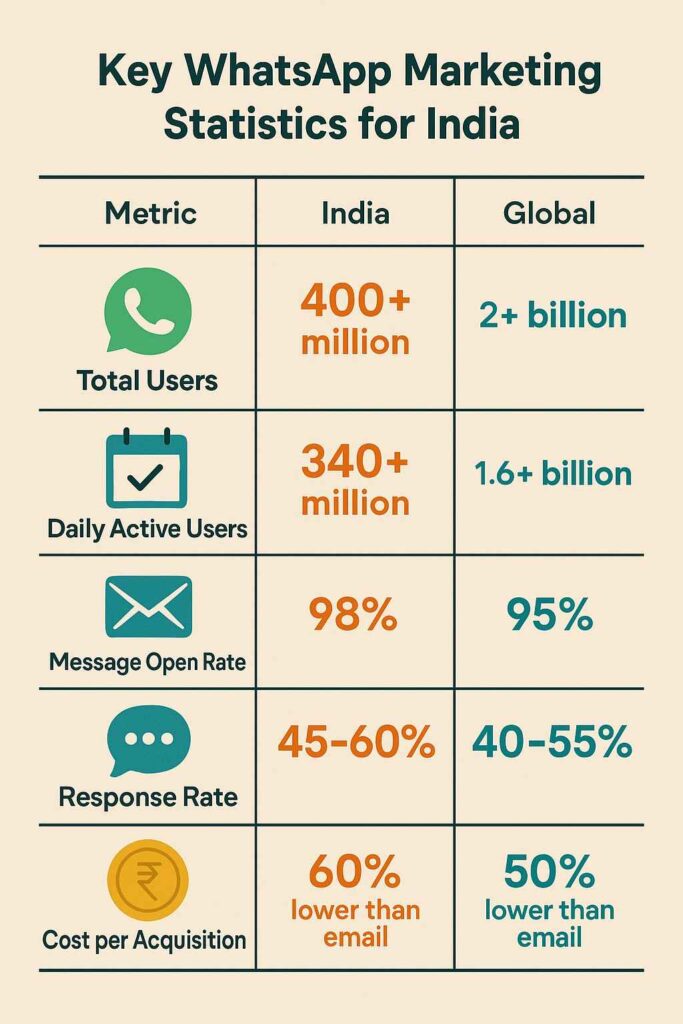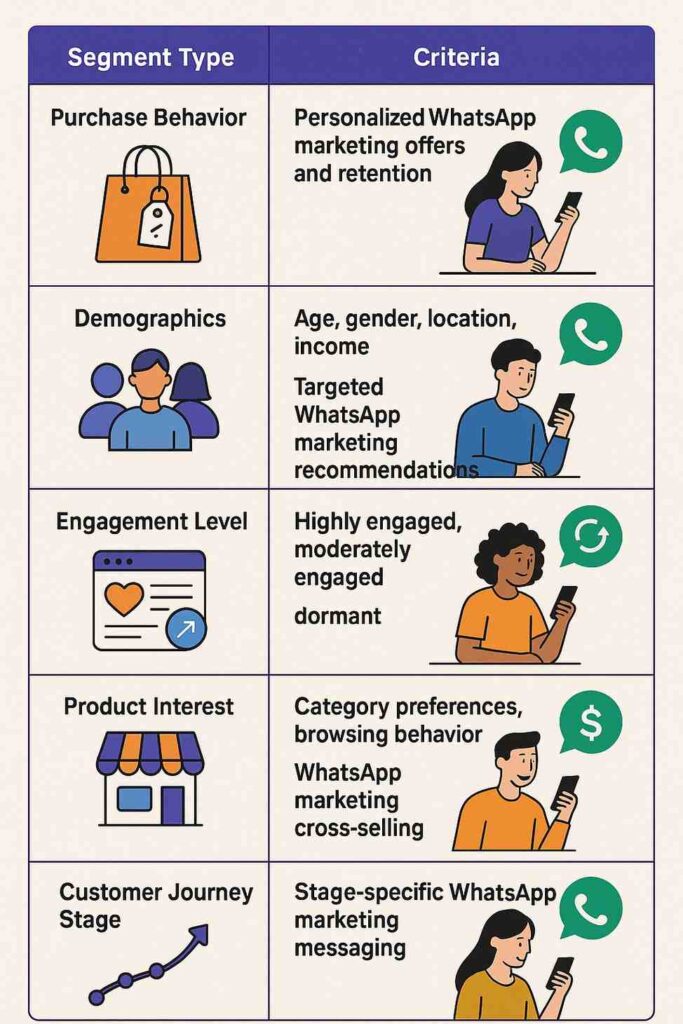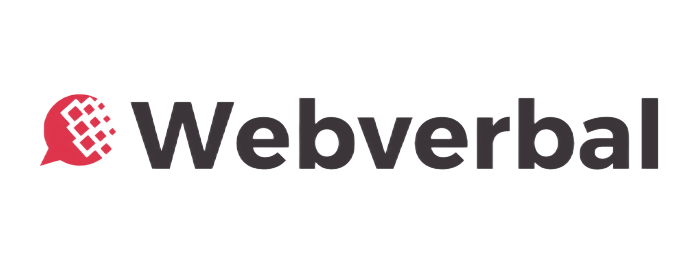Table Of Content
- Why WhatsApp Marketing is Essential for Indian Brands
- Key WhatsApp Marketing Statistics for India
- The Complete WhatsApp Marketing Strategy Framework
- 1. Setting Up Your WhatsApp Business Foundation
- 2. Audience Segmentation Strategies
- 3. Content Strategy That Works
- Real Indian Success Stories: Case Studies
- Case Study 1: Nykaa’s WhatsApp Revolution
- Case Study 2: Swiggy’s Food Delivery Excellence
- Case Study 3: Titan’s Jewelry Journey
- Advanced WhatsApp Marketing Tactics
- 1. Automation That Feels Human
- 2. Integration with Other Marketing Channels
- 3. Measuring Success: Key Metrics That Matter
- Implementation Roadmap: Your 90-Day Plan
- Month 1: Foundation Building
- Month 2: Content and Engagement
- Month 3: Scale and Optimize
- Common Mistakes to Avoid
- The Future of WhatsApp Marketing in India
- Getting Started: Your Action Plan
- Conclusion
- Frequently Asked Questions
WhatsApp marketing has revolutionized how brands connect with customers in India and globally. With over 400 million users in India alone, WhatsApp marketing offers unprecedented opportunities for businesses to build meaningful relationships with their audience through this powerful messaging platform.
As someone who has helped hundreds of brands leverage WhatsApp marketing strategies, I’ve seen firsthand how this platform can transform customer engagement when used strategically. Today, I’ll share the complete WhatsApp marketing playbook that has generated millions in revenue for our clients.
While WhatsApp has become a cornerstone for direct-to-consumer communication, the bigger shift lies in how social commerce platforms are transforming Indian e-commerce in 2025 — blending community, discovery, and instant transactions. Read the full market analysis & case studies here.
Why WhatsApp Marketing is Essential for Indian Brands
WhatsApp isn’t just a messaging app in India—it’s become the primary communication channel for millions of users. The platform’s high engagement rates and personal nature make it perfect for building trust, especially in the Indian market where relationships matter most.

Key WhatsApp Marketing Statistics for India
| Metric | India | Global |
|---|---|---|
| Total Users | 400+ million | 2+ billion |
| Daily Active Users | 340+ million | 1.6+ billion |
| Message Open Rate | 98% | 95% |
| Response Rate | 45-60% | 40-55% |
| Customer Satisfaction | 87% | 82% |
| Cost per Acquisition | 60% lower than email | 50% lower than email |
These WhatsApp marketing numbers tell a compelling story. When done right, WhatsApp marketing delivers results that traditional channels simply cannot match.
The Complete WhatsApp Marketing Strategy Framework
1. Setting Up Your WhatsApp Business Foundation
Before jumping into campaigns, you need a solid foundation. Here’s what I recommend to every brand:
WhatsApp Business API Setup
- Choose between WhatsApp Business App (small businesses) or Business API (enterprises)
- Set up your business profile with complete information
- Create automated welcome messages
- Implement chatbot flows for common queries
Essential Profile Elements:
- Professional business name
- High-quality logo/profile picture
- Detailed business description
- Contact information and website link
- Business hours and location (if applicable)
2. Audience Segmentation Strategies

Smart segmentation is what separates successful WhatsApp campaigns from spam. Here’s how I segment audiences for maximum impact:
| Segment Type | Criteria | Use Case |
|---|---|---|
| Purchase Behavior | First-time buyers, repeat customers, high-value customers | Personalized offers and retention |
| Demographics | Age, gender, location, income | Targeted product recommendations |
| Engagement Level | Highly engaged, moderately engaged, dormant | Re-engagement campaigns |
| Product Interest | Category preferences, browsing behavior | Cross-selling and upselling |
| Customer Journey Stage | Awareness, consideration, purchase, post-purchase | Stage-specific messaging |
3. Content Strategy That Works
The key to WhatsApp marketing success lies in providing value, not just pushing products. Here’s my proven content mix:
The 80/20 Rule:
- 80% valuable, non-promotional content
- 20% promotional messages
Content Types That Drive Engagement:
| Content Type | Engagement Rate | Best Use Case |
|---|---|---|
| Behind-the-scenes content | 72% | Brand building |
| Customer testimonials | 68% | Social proof |
| Product tutorials | 65% | Education and support |
| Exclusive offers | 78% | Sales conversion |
| Industry insights | 58% | Thought leadership |
| User-generated content | 71% | Community building |
Real Indian Success Stories: Case Studies
Case Study 1: Nykaa’s WhatsApp Revolution
Nykaa, India’s leading beauty retailer, transformed their customer service using WhatsApp Business API. Here’s what they achieved:
Challenge: Managing customer queries across multiple beauty brands and products while maintaining personalized service.
Strategy:
- Implemented AI-powered chatbots for instant responses
- Created personalized beauty consultations via WhatsApp
- Launched exclusive product previews for VIP customers
- Set up automated order tracking and delivery updates
Results:
- 40% reduction in customer service response time
- 25% increase in customer satisfaction scores
- 15% boost in repeat purchase rate
- 300% increase in WhatsApp engagement
Key Takeaway: Personalization at scale is possible when you combine automation with human touch.
Case Study 2: Swiggy’s Food Delivery Excellence
Swiggy leveraged WhatsApp to enhance their food delivery experience and build stronger customer relationships.
Challenge: Standing out in the competitive food delivery market while reducing customer acquisition costs.
Strategy:
- Created location-based restaurant recommendations
- Launched “Swiggy Stories” sharing food trends and recipes
- Implemented order status updates via WhatsApp
- Started exclusive deals for WhatsApp subscribers
Results:
- 30% increase in order frequency from WhatsApp users
- 20% higher customer lifetime value
- 45% improvement in customer retention
- 50% reduction in support ticket volume
Key Takeaway: WhatsApp works best when integrated into your core business operations, not as a standalone channel.
Case Study 3: Titan’s Jewelry Journey
Titan Watches used WhatsApp to recreate the personal shopping experience digitally.
Challenge: Replicating the intimate, consultative experience of jewelry shopping online.
Strategy:
- Trained jewelry consultants to provide expert advice via WhatsApp
- Created virtual try-on experiences using AR
- Launched festival-specific collections through WhatsApp first
- Implemented appointment booking for store visits
Results:
- 60% increase in consultation-to-purchase conversion
- 35% higher average order value
- 90% customer satisfaction rate for WhatsApp consultations
- 25% increase in store visit appointments
Key Takeaway: WhatsApp can bridge the gap between digital and physical retail experiences.
Advanced WhatsApp Marketing Tactics
1. Automation That Feels Human
The best WhatsApp automation doesn’t feel automated. Here’s my framework for creating natural conversational flows:
Smart Automation Rules:
- Always provide an option to talk to a human
- Use conditional logic based on user responses
- Implement natural language processing for better understanding
- Create fallback responses for unexpected queries
2. Integration with Other Marketing Channels
WhatsApp works best as part of an integrated marketing ecosystem:
| Integration | Benefits | Implementation |
|---|---|---|
| Email Marketing | Abandoned cart recovery | Send WhatsApp follow-ups for unopened emails |
| Social Media | Lead generation | Use WhatsApp as CTA in Instagram/Facebook ads |
| Website | Instant support | Add WhatsApp chat widgets |
| CRM Systems | Unified customer view | Sync WhatsApp conversations with customer profiles |
| SMS Marketing | Multi-channel messaging | Use WhatsApp for rich media, SMS for alerts |
3. Measuring Success: Key Metrics That Matter
Tracking the right metrics ensures your WhatsApp marketing delivers ROI:
Primary Metrics:
| Metric | Industry Benchmark | Target Range |
|---|---|---|
| Message Delivery Rate | 95%+ | 98%+ |
| Message Open Rate | 90%+ | 95%+ |
| Response Rate | 30-40% | 45%+ |
| Conversion Rate | 5-10% | 12%+ |
| Customer Acquisition Cost | Varies by industry | 50% lower than other channels |
| Customer Lifetime Value | Varies by industry | 20% higher than average |
Secondary Metrics:
- Session duration on WhatsApp
- Number of messages per conversation
- Time to resolution for support queries
- Customer satisfaction scores
- Referral rates from WhatsApp users
Implementation Roadmap: Your 90-Day Plan
Month 1: Foundation Building
- Set up WhatsApp Business API or App
- Create and optimize business profile
- Develop initial automation flows
- Train team on WhatsApp best practices
- Launch with existing customer base
Month 2: Content and Engagement
- Implement content calendar
- Launch first promotional campaigns
- Begin collecting customer feedback
- Optimize automation based on early data
- Start integrating with other marketing channels
Month 3: Scale and Optimize
- Expand to new customer segments
- Launch advanced features (catalogs, payments)
- Implement advanced analytics
- Create case studies from early wins
- Plan for next quarter expansion
Common Mistakes to Avoid
From my experience helping brands navigate WhatsApp marketing, here are the biggest pitfalls to avoid:
1. Being Too Promotional The quickest way to get blocked is to treat WhatsApp like an email blast channel. Focus on value first, sales second.
2. Ignoring Timing WhatsApp messages feel more intrusive than emails. Respect your audience’s time and avoid sending messages during odd hours.
3. Poor List Management Always obtain explicit consent before adding users to your WhatsApp lists. Non-compliance can lead to account suspension.
4. Lack of Personalization Generic messages perform poorly on WhatsApp. Use the data you have to create personalized experiences.
5. Neglecting Customer Support WhatsApp users expect quick responses. If you can’t respond within a few hours, set proper expectations.
The Future of WhatsApp Marketing in India
WhatsApp continues to evolve, and smart brands are already preparing for what’s next:
Emerging Trends:
- WhatsApp Shopping integration
- Advanced AI and NLP capabilities
- Voice message marketing
- Group commerce features
- Enhanced business analytics
Preparation Strategies:
- Invest in AI and automation technologies
- Build comprehensive customer databases
- Develop multimedia content capabilities
- Focus on community building
- Prepare for commerce integration
Getting Started: Your Action Plan
Ready to transform your marketing with WhatsApp? Here’s your immediate action plan:
- Audit Your Current Setup – Review your existing WhatsApp presence and identify gaps
- Define Your Goals – Set clear, measurable objectives for your WhatsApp marketing
- Choose Your Tools – Select the right WhatsApp solution for your business size and needs
- Create Your Content Strategy – Develop a content calendar that provides value to your audience
- Launch Small – Start with a pilot campaign to test and learn
- Measure and Optimize – Use data to continuously improve your approach
Conclusion
WhatsApp marketing isn’t just about sending messages—it’s about building relationships at scale. The brands that succeed are those that understand the personal nature of the platform and respect their audience’s trust.
The opportunity in India is massive. With smartphone penetration increasing and digital literacy growing, WhatsApp will continue to be the bridge between brands and consumers. The question isn’t whether you should be using WhatsApp marketing—it’s how quickly you can implement these strategies to stay ahead of your competition.
Remember, successful WhatsApp marketing is a marathon, not a sprint. Focus on providing value, building trust, and creating genuine connections with your audience. The results will follow.
Ready to revolutionize your marketing with WhatsApp? Start implementing these strategies today, and watch your customer relationships transform.
Frequently Asked Questions
WhatsApp marketing is extremely effective for Indian businesses, with message open rates reaching 98% compared to 20-25% for email marketing. Indian brands using WhatsApp see 60% lower customer acquisition costs and 45-60% response rates. The platform’s popularity in India, with over 400 million users, makes it an essential channel for customer engagement and sales conversion.
WhatsApp Business App is free and designed for small businesses with up to 5 devices, offering basic features like business profiles and quick replies. WhatsApp Business API is a paid solution for medium to large enterprises, providing advanced features like chatbots, unlimited messaging, multiple user access, and integration with CRM systems. API is required for businesses sending over 1,000 messages per day.
To legally collect WhatsApp opt-ins in India, you must obtain explicit consent before adding customers to your list. Use methods like website pop-ups, QR codes, social media campaigns, or in-store sign-ups with clear privacy policies. Always provide easy opt-out options and never add numbers without permission, as this violates WhatsApp’s terms of service and can result in account suspension.
High-performing WhatsApp content includes behind-the-scenes content (72% engagement), exclusive offers (78% engagement), customer testimonials (68% engagement), and product tutorials (65% engagement). Follow the 80/20 rule: 80% valuable, non-promotional content and 20% promotional messages. Visual content like images, videos, and voice notes typically generate higher engagement than text-only messages.
WhatsApp Business App is free for small businesses. WhatsApp Business API costs vary by provider, typically ranging from ₹2,000-₹15,000 per month depending on message volume and features. Conversation-based pricing starts at approximately ₹0.04-₹0.10 per conversation. Additional costs include chatbot development (₹50,000-₹2,00,000) and integration services, making it significantly more cost-effective than traditional advertising channels.
Effective WhatsApp automation should feel conversational and human-like. Use natural language, provide options to connect with human agents, implement conditional logic based on user responses, and avoid overly formal language. Create fallback responses for unexpected queries, use emojis appropriately, and personalize messages with customer names and relevant information. Always test your automation flows with real users before launching.




